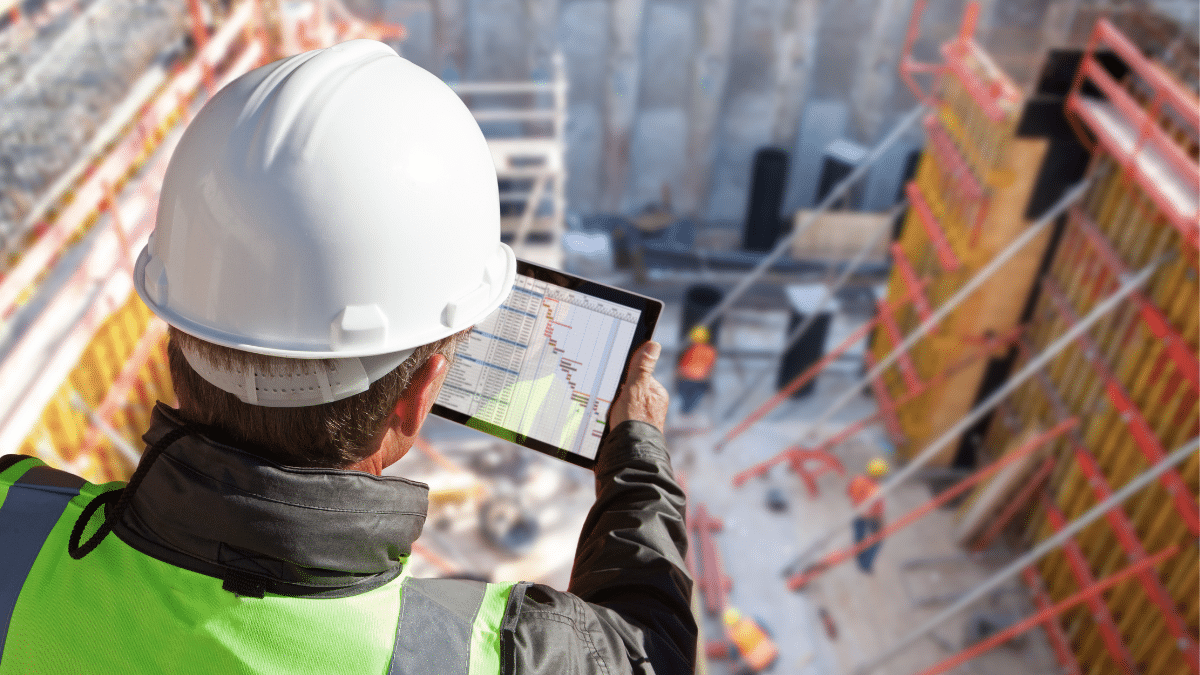Key Takeaways:
- Construction fleet tracking prevents theft by providing you with real-time insights into the whereabouts of your vehicles and alerting you if they veer off their scheduled route.
- It makes it possible to protect your assets from theft by notifying you if your vehicles leave the designated areas.
- Tracking your construction fleet also helps with recovering stolen assets if theft does occur.
High fences, padlocks, surveillance cameras, and security alarms—these are all staples of construction site security and equipment theft prevention.
However, did you know that the way you manage your fleet can also play a crucial role in combating this serious issue?
That’s right.
With the right fleet tracking system in place, you’re not just keeping an eye on your machines, but you’re actively deterring this sort of crime and even boosting your chances of recovering stolen assets.
Want to know more?
Let’s delve into the specifics!
In this article...
Allows Real-Time Monitoring
Real-time fleet monitoring allows you to keep constant watch over your equipment, ensuring you always have fresh and precise information on its every move.
This means that if, say, a vehicle veers off its scheduled route or enters/exits a restricted area without permission, you’ll be promptly alerted, which enables you to take swift action and reduce the chances of losing that asset for good.
Put simply, with real-time tracking, you’re always made aware of suspicious activities as they occur—not five minutes later, not an hour later, and definitely not the following day.
Such capability is invaluable because, let’s be honest, the faster you respond to theft, the greater the likelihood of recovery.
Another thing to keep in mind is that fleet tracking systems don’t just keep tabs on asset location but also provide up-to-date insights into who is using each piece of equipment.
As Trey Hoffman, vice president of products at QuantHub, points out, knowing the responsible party for each machine adds an extra layer of assurance and security, while also fostering accountability among workers.

This feature is particularly useful for identifying insider thieves, who are notoriously difficult to apprehend.
What makes them so challenging to detect and catch is their ability to blend in on job sites, as well as the transient nature of construction work itself, with its frequent turnover of temporary workers.
In fact, did you know that slightly over a quarter of construction thefts are carried out precisely by insiders, according to research from BauWatch?
That’s certainly not something to glance over.

Still, with minute-by-minute updates on vehicle movement and usage, identifying suspects becomes much easier, even if they attempt to pass as members of your team.
The bottom line is this: never underestimate the importance of real-time asset data in deterring theft.
Even a brief delay between the occurrence of an incident and your becoming aware of it can provide ample opportunity for perpetrators to get away with your valuable machinery, never to be recovered.
Enables the Creation of Virtual Boundaries
Implementing virtual boundaries, known as geofences, enables you to establish a digital perimeter around specific areas such as job sites or warehouses, in order to restrict and monitor your fleet’s activity.
Should someone enter or exit these zones without permission, or outside scheduled times, your fleet tracking system notifies you immediately.
In other words, with geofencing, you can dictate and oversee the movement of your machinery much more easily than ever before, ensuring it’s always right where it needs to be.
In the image below, you can see the geofencing feature within our own asset management solution GoCodes Asset Tracking.

Setting up geofences with our system is remarkably simple.
All you need are our GPS trackers that are attached to your equipment and the GoCodes Asset Tracking cloud-based software.
Using available cell phone signals or Wi-Fi, our compact, yet powerful tracking devices transmit location data for each machine in real time.
You can see what they look like below.

This data is then accessed through the software, either via your phone or computer.
Of course, if a machine breaches the virtual parameter you set up, GoCodes Asset Tracking alerts you right away so you can act on time, even involving law enforcement if necessary, to protect your assets.
Think about it: fences have always been a vital part of any efficient security system.
They enable better access control, create a protective barrier around valuable assets, and deter trespassers.
Geofencing operates on the same principle but kicks it up a notch by providing real-time monitoring and warning you instantly if there’s a potential threat to your fleet.
By doing so, it makes sure your assets stay safe and sound, and always right where they should be—under your vigilant control.
Acts as a Deterrent
Most fleet monitoring systems rely on various forms of identification labels or tracking devices that must be affixed to heavy machinery, equipment, and vehicles.
These may include, for instance, QR code asset labels you scan with your phone to view or update equipment data, BLE beacons that transmit location data to nearby Bluetooth-enabled devices, or the real-time GPS trackers we mentioned earlier.

All of them serve the same purpose: to make fleet tracking easier.
However, they also have another, albeit indirect, role, and that’s to deter thieves from stealing your equipment.
When thieves notice these devices and markings on your assets, they immediately know they are being monitored, often dissuading them from going through with their endeavor.
For many criminals, especially those looking for an easy target, this may simply be a challenge not worth their trouble.
And the more difficult it is to remove these labels and tags, the better.
Gabe Marquez, a special agent with the National Insurance Crime Bureau (NICB), agrees that the effort and time required to take off tracking devices can be significant deterrents for criminals.

Plus, even if they do take something, those tags simplify equipment identification, serving as proof of ownership and aiding in recovery efforts.
Now, don’t throw away your surveillance cameras and alarms just yet.
They are super effective when it comes to identifying perpetrators or catching them in the act and should, therefore, still be a part of your security system.
Nevertheless, having a tool that discourages thieves from attempting theft altogether is far more valuable.
Alexis Potter, managing director at Bauwatch, emphasizes that professionals in the construction industry should be focusing more effort on preventing criminals from stealing, rather than catching them after the fact.

Fleet monitoring helps you do just that.
It serves as an excellent preventive measure, signaling to robbers that your machinery is under vigilant surveillance—a risk few would be willing to take.
Helps with Asset Recovery
Now, despite all your efforts, some thieves just won’t back down from carrying out their intentions.
In fact, when the potential loot is too tempting to resist, they’ll stop at nothing to get their hands on it.
As Paul Worsley, director of service at Kingdom Systems, says, theft in construction definitely isn’t going anywhere.

The demand for stolen equipment is at an all-time high, and the hefty price tag of these machines, coupled with the fact they are quite difficult to recover, are only a few of the reasons this problem is so persistent.
And sure, you may not have much influence over the first two factors, but the last one is where you can make a real difference—and absolutely should.
You can do so by implementing GPS fleet tracking as it substantially boosts the chances of recovering stolen assets.
The moment your equipment goes missing or gets tampered with, the system alerts you about this suspicious activity, giving you the upper hand to act fast and even involve law enforcement if needed.
You can then provide the police with all they need to find and catch the culprit, including asset location and use history.
This is precisely how Cable East Inc., a telecommunications construction company based in northern Georgia, was able to prevent $2.5 million worth of equipment from being lost forever.
Billy Porter, the company’s director of risk management, notes that theft had long been a challenge for them, with stolen machinery often disappearing without a trace.
However, that all changed when they outfitted their machines with GPS trackers.
They displayed asset location in real-time, and simultaneously served as proof of ownership, leading to the quick and painless recovery of their machines:
“Thieves typically take things deep in the woods, in warehouses and other areas where we would not be able to see them. We’ve been able to track the assets on GPS and notify law enforcement. They secure the scene and we’re able, in real time, to provide our folks with everything they need, from bill of sale to title, to substantiate our ownership.”
All in all, equipment theft will probably remain a significant concern in the construction sector for the foreseeable future.
Still, there’s no denying that technology is making things significantly harder for thieves.
Thanks to the fleet monitoring systems keeping an eagle eye on your fleet, perpetrators, even if they manage to take what they came for, are far more likely to be caught than ever before, making it much easier for you to retrieve your valuable assets.
Conclusion
Theft prevention will always require a multilayered approach; that much is for sure.
There’s simply no magic solution that guarantees 100% success when it comes to deterring thieves.
However, few security measures rival the effectiveness of fleet management systems.
They can be a huge game-changer for your fleet’s security, enabling you to monitor your machines and vehicles in real time and receive immediate alerts upon the first sign of unauthorized movement.
So if theft is your current concern, don’t despair.
Instead, start exploring fleet tracking systems today.
Once you’ve got them up and running, you’ll find yourself wondering why you hadn’t embraced them sooner.





